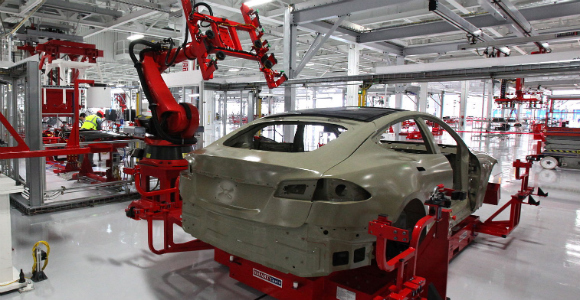
Technology is having a big impact on the state of manufacturing here in California. Tesla factory in Fremont, CA. (Photo Credit: Steve Jurvetson)
A report out this week on California manufacturing has both a good news and a bad news component to it.
Between 1990 and 2012, California lost 842,000 manufacturing jobs. That’s the bad news. The good news is that California still contributes more to the country’s manufacturing than any other state.
The report, by Los Angeles County Economic Development Corporation (LAEDC) and titled California’s Manufacturing Industries: Employment and Competitiveness in the 21st Century, says California generates 11.4 percent of the nation’s manufacturing GDP, ahead of Texas (10 percent). Also, it appears that manufacturing is on the rebound in the state.
Part of what is happening in manufacturing is the impact technology is having on the sector.
“Manufacturing continues to become more technologically advanced and more lean,” says economist Christine Cooper, who co-authored the study. “It means that productivity is soaring but employment is not, so we continue to lose employment in manufacturing jobs while our output and the value of our output keep increasing.”
This topic will be further discussed on August 12 in Sacramento at the California Economic Summit – Capitol Day, which is expected to attract around 300 leaders (here’s a link to the program).
The Summit’s Advancing Manufacturing Action Team has been working on way to capture and to keep manufacturing jobs in the Golden State. A big part of that success will be based on our ability to better train workers for the new economy.
The Summit, a project of California Forward and the California Stewardship Network, is made of hundreds of leaders working together to promote workforce and infrastructure investments, innovation in regulations and access to capital, smart housing and working landscape policies.
As meetings have been held around California the last three years as part of the Summit process, workforce development has been a consistent theme.
Not surprisingly the LAEDC manufacturing report has a huge workforce emphasis as well.
Because manufacturing processes in both high technology and low technology industries are becoming more dependent on technology (both hardware and software), specific training continues to be needed.
The speed of innovation today demands that industry be involved in developing appropriate training programs and in forming partnerships with learning centers and colleges so that candidates are job ready for available occupations.
Politically, the high-tech manufacturing sector is a popular topic for elected officials. Allen Young of the Sacramento Business Journal wrote a piece this week that says advanced manufacturing is an area where elected officials will say “yes” to tax credits.
While we continue to try to capture new manufacturing opportunities and keeping old ones, California can rest easier than some other states. Manufacturing is important, but the state is not as dependent on it as some other states. Manufacturing’s 10.7 percent share of the state’s GDP is much less than the 31.9 percent in Oregon, the 29.5 percent in Indiana and the 21 percent in North Carolina.
Still, it is a vital piece of the state’s economy, as manufacturing workers are paid more on average, and the sector’s exports have a big impact on our competitiveness.
We will leave with you with this positive thought—the manufacturing climate is improving.
This LA Times story on the Beacon Economics Report indicates that manufacturing and exports have been fueling the state’s economic engine lately, and that 56 percent of the new jobs created in California in 2013 had annual wages above $50,000.

